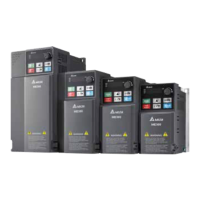How to troubleshoot OFF POWER LED on Delta DC Drives?
- RRobert DayAug 10, 2025
If the POWER LED is off, it indicates no power. Check if the connection between the CMM-PD02 and the AC motor drive is normal.

How to troubleshoot OFF POWER LED on Delta DC Drives?
If the POWER LED is off, it indicates no power. Check if the connection between the CMM-PD02 and the AC motor drive is normal.
What to do if the Delta DC Drives NET LED flashes orange?
If the NET LED flashes orange, it means that the CMM-PD02 fails to communicate with the AC motor drive. To solve this, switch off the power and check whether the CMM- PD02 is correctly installed and normally connected to the AC motor drive.
Why is the NET LED on my Delta KPMS-LE01 red?
A red light on the NET LED indicates that the CMM-PD02 is not connected to the PROFIBUS DP bus. To resolve this, connect the CMM-PD02 to the PROFIBUS DP bus.
What to do if the Delta DC Drives NET LED flashes red?
If the NET LED flashes red, it signifies an invalid PROFIBUS communication address. To fix this, set the PROFIBUS address of the CMM-PD02 between 1–125 (decimal).
Provides details about the information found on the AC drive's nameplate, including model, input/output voltage, and certifications.
Presents dimensional drawings and specifications (W, H, D, W1, H1, D1, S1) for Frame A models of the AC motor drive in mm and inches.
Provides dimensional drawings and specifications (W, H, D, W1, H1, D1, S1) for Frame B models of the AC motor drive in mm and inches.
Details the dimensions (W, H, D, W1, H1, D1, S1) for Frame C models of the AC motor drive, presented in mm and inches.
Shows dimensional drawings and specifications (W, H, D, W1, H1, D1, S1) for Frame D models of the AC motor drive, in mm and inches.
Contains dimensional drawings and specifications (W, H, D, W1, H1, D1, S1) for Frame E models of the AC motor drive, in mm and inches.
Provides dimensional drawings and specifications (W, H, D, W1, H1, D1, S1) for Frame F models of the AC motor drive, in mm and inches.
Details the minimum mounting clearances (A, B, C) required for single drive, side-by-side, and zero stack installations, considering ambient temperature.
Presents airflow rates and power dissipation data for various AC motor drive models across different frames (A, B, C, D, E, F).
Illustrates the system wiring diagram for the AC motor drive, including power input, NFB/fuse, contactors, reactors, and motor connections.
Provides detailed wiring diagrams for input, output, and control terminals of the AC motor drive, including precautions.
Shows the main circuit diagram for one-phase and three-phase power input, detailing terminals and descriptions for AC reactor, brake resistor, and DC circuit.
Specifies ring lug dimensions and wire gauge requirements for main circuit terminals across different drive frames.
Details wiring specifications for control terminals, including stripping length, wire gauge, and tightening torque for relay and control terminals.
Lists applicable motors, braking torque, resistor specifications, and maximum braking torque for various voltage and phase models.
Provides selection recommendations for magnetic contactors and air circuit breakers based on heavy duty input and output current.
Lists recommended branch circuit fuses (input current and P/N) for various AC motor drive models and voltage/phase configurations.
Provides recommended EMC filters and zero phase reactors based on frame, motor drive model, input current, and conducted/radiated emission requirements.
Details motor parameters including auto-tuning, full-load current, rated power, speed, poles, and resistance/inductance for induction and permanent magnet motors.
Covers low voltage level, over-voltage/current stall prevention, over-torque detection, electronic thermal relay selection, and stall prevention limit level.
Explains terminal selection for PID feedback, proportional/integral/differential gains, output command limits, and feedback signal settings.
Provides detailed descriptions of drive parameters, including identity code, rated current display, parameter reset, and startup display settings.
Explains the Safe Torque Off (STO) function of the MS300 series, its international standards compliance, and provides a circuit diagram.
Describes the STO related terminal functions (+24V, S1, S2, DCM) and the action logic and keypad display after S1/S2 signal input.
Shows the internal circuit diagram of the safe control loop and the wiring diagram for the STO function, including notes on jumper wire usage.
Provides error code descriptions for STO related faults (72, 76, 77, 78) and troubleshooting instructions for KPMS-LE01 keypad.
Guides users through the steps to verify STO and related detection functions, including normal operation, STO, STL1, and STL2 status checks.












